A doctoral student at the University of Michigan has created a sonic representation of the intense solar storm that erupted in early March. Robert Alexander gathered 90 hours of raw data from two NASA spacecraft–the MESSENGER and the Solar and Heliospheric Observatory. Through isomorphic mapping, he applied that data to an audio waveform. The resulting sound lasted only a fraction of a second, so Alexander used algorithms to extend the playback length. The final soundtrack portrays a cacophony of solar particles emitted by the storm as they slammed into the spacecraft. Listen for yourself in the clip below.
A National Network of Networks: The Discussion Continues
by James Stalker, CEO, RESPR, Inc., and Chair, R&D/Testbeds Working Group for the AMS Ad Hoc Committee on a Nationwide Network of Networks
The National Research Council (NRC) report, titled “Observing the Weather and Climate From the Ground Up: A Nationwide Network of Networks (2009),” provided the vision and inspiration for building a team of volunteers from across all three sectors (government, academia, and private) that investigated the
suggestions recommended in the report. This team, comprising six (6) working groups (Organization and Business Models, Architecture, Measurements and Infrastructure, Metadata Policy, R&D and Testbeds, and Human Dimension), spent more than two years considering how to refine the recommendations and tackle the challenges identified in the original NRC report. They also identified other challenges in shaping this type of Nationwide Network of Networks (NNoN), which will be of critical importance to our country’s weather-ready future.
This volunteer team has published additional recommendations compiled into a draft report available at the American Meteorological Society website. Several drafts of this team’s report had been made available to the larger weather and climate enterprise community for comments over many months. The most recent and final version of the report reflects the community input. The readers of this blog are encouraged to read this final report and provide their comments to the Committee Chair and/or any of the Working Group Chairs of the Ad Hoc Committee on Network of Networks.
These volunteer efforts, to date, have certainly tried to solidify the interest of the various stakeholders in a network of this magnitude and of national importance but a lot more work remains to be undertaken. Unfortunately, many challenges remain unresolved. For example, wide-spread support hasn’t been secured for the idea of a central authority for an organizing body of the NNoN. Despite the best efforts by the volunteer team, an appealing organization and business model for such a central body has not been settled on going forward. Other challenges include establishing how to:
- make this organizing body an autonomous body that is not unduly influenced by any one sector,
- make this body a financially sustainable entity in the long run,
- reach all the major stakeholders and get them to support this idea and contribute to its success.
With respect to the third challenge listed above, many of the sought-after stakeholders may not be actively engaged in the weather and climate enterprise community activities and so finding effective ways to reach them becomes an even bigger challenge.
On a positive note, however, the NNoN efforts are going to be discussed again and support will be sought at the AMS Washington Forum in April 2012 and also at the Summer Community Meeting in August 2012 in Norman, Oklahoma. These two venues should prove quite useful for any interested Weather and Climate Enterprise participant and other stakeholders in the overarching effort to build a national asset that the current and many future generations will help nurture and benefit from.
Small Microbes Play Big in Climate Arena
Microbes may be small, but they shouldn’t be ignored when considering global climate. According to a new colloquium report from The American Academy of Microbiology, microbes such as bacteria, algae, and fungi play a powerful role in the Earth’s climate. “Incorporating Microbial Processes into Climate Models” notes how the impact of microbes on the atmosphere goes way back in time. The critical mix of carbon dioxide and oxygen we take for granted as sustaining life on the planet is due to the rise of these tiny creatures eons ago.
So what specifically do these minute forms of life have to do with climate today? According to the report, the answer is plenty. “The sum total of their activity is enormous. But of course not all microbes are the same—some of them are producing oxygen, others are consuming it. Some are taking carbon dioxide out of the air, others are adding it.”
The big questions that the report asks and plans to address by incorporating microbial processes into climate change models: what’s the overall effect of microbial activities on the concentration of carbon dioxide in the atmosphere? Is it possible this activity will absorb the carbon dioxide being added to the atmosphere? Or will the rising global temperature might spur microbes to produce even more carbon dioxide?
The authors recognize that the gap between the climatology and microbiology is large, but they say it is not insurmountable. Some of the same technologies used to collect data for climate models—satellite imaging of cloud cover and precipitation, submarine cables that monitor changes in temperature and salinity, sensors to retrieve real-time data from remote locations—can also be applied to measuring biological phenomena. Collaboration between the sciences, they believe, will benefit both fields.
A more detailed look at the report is available here.
Upping the Ante on Modeling Climate Change Impacts
There is a growing urgency to produce global projections of how a warming climate could affect life on Earth.
“Impact research is lagging behind physical climate sciences,” says Pavel Kabat, director of the International Institute for Applied Systems Analysis (IIASA) in Austria. “Impact models have never been global, and their output is often sketchy. It is a matter of responsibility to society that we do better.”
Time is running out for researchers hoping to contribute impact simulations to the IPCC’s Fifth Assessment Report (scheduled for publication in 2014). So last month, the IIASA and the Potsdam Institute for Climate Impact Research (PIK) started a project to compare climate-impact models collected from more than two dozen research groups in eight countries. The Inter-Sectoral Impact Model Intercomparison Project (ISI-MIP) will integrate climate data from state-of-the-art models, using a range of greenhouse-gas emission scenarios (models used in the project can be found here). Because the various emissions scenarios result in a range of projected global temperature increases, potential impacts also can vary widely across a range of scenarios. It is hoped that the project will clarify systematic biases that can cause models to produce disparate results.
The models will investigate the effects of climate change on global agriculture, water supplies, vegetation, and health. Results are due by July 1, and reports on each of the four impact areas are scheduled to be completed by January of 2013. This means the data could be available for the IPCC’s next report–which “will make a real difference for the assessment process,” notes Chris Field of the Carnegie Institution for Science, cochair of IPCC Working Group II. “I greatly appreciate the initiative required to get this activity underway, and I appreciate the commitment to fast-track components that will yield results in time for inclusion in the IPCC Fifth Assessment Report.”
The ISI-MIP is scheduled to continue into 2013 and could be expanded to analyze climatic impacts on transport and energy infrastructures.
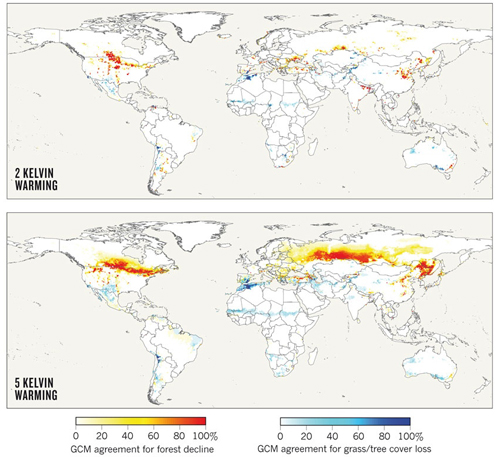
Eurasian Cold Snap a Product of Arctic Warmth
In a paradox that it seems only nature can muster—like quelling a year-long drought in the western two-thirds of Texas with record snows—it turns out that warming going on in the Arctic this winter is the likely culprit behind killer cold and snow that had been plaguing Eastern Europe since late January. And it is now also likely linked to the colder-than-normal winter occurring in Japan and Western Asia.
Weather patterns since the fall have set up in such a way as to leave large expanses of Arctic Ocean, particularly the Barents and Kara Seas north of Scandinavia and Russia, nearly ice-free. In fact, an image from early February posted to the Arctic Sea Ice Blog shows this area north of the Arctic Circle as open water for the first time in what it refers to as the “new Arctic regime (2005-present),” when it should be completely frozen over.
The changing weather patterns resulting from this new era of record sea ice melt seem to have helped build up a huge helping of frigid air over Siberia that came crashing southward as soon as the storm track shifted, which it inevitably does throughout the year. Instead of Western Europe like the last two winters, this time the bitter cold targeted Eastern Europe, delivering snow-laden storms to nations of the Eastern Mediterranean and even North Africa, as well as far Western Asia, Korea, and Japan.
Numerous researchers have been working the last few years to figure out what’s going on. The environmental news and technology site Bits of Science wrote a timely online article explaining the findings of recent published research and then tying the studies to the different teleconnections patterns that influence Eurasia’s winter weather — the Arctic Oscillation and its focused cousin, the North Atlantic Oscillation. Together, these pressure anomaly-driven climate patterns can dictate where winter’s worst cold and snow and best warmth become established.
A new study headed for publication in the Journal of Climate in March further extends the influence of the warming Arctic. The article by the Research Institute for Global Change’s Jun Inoue et al. contends that the storm track over the Barents and Lara Seas takes a more northerly route when sea ice there is reduced. In a positive feedback mechanism, the northward-shifted storm track pulls warm air over the Arctic Ocean. At the same time, cold air builds over Siberia and the Norwegian coast, and becomes poised to spill southward, or to the west and the east.
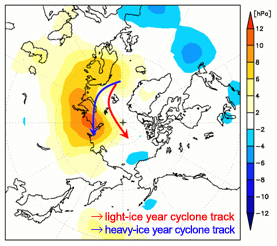
“Such warm Arctic and cold continental conditions are referred to as a warm-Arctic cold-Siberian (WACS) anomaly, and the WACS anomaly could be a procurer of severe weather in the downstream region,” the authors report.
As with the collective research on the warming Arctic’s influence on mid-latitude winter weather, Inoue et al. conclude that using sea-ice variability from this region of the Arctic would improve the reliability of the seasonal weather predictions in individual years.
AMS Members Surveyed on Climate Change
by Ray Ban, Andrea Bleistein, and Paul Croft, of the AMS Committee to Improve Climate Change Communication (CICCC)
Most AMS Members apparently agree that there is conflict among their colleagues in the Society on the issue of climate change. Those who perceive the conflict on this issue generally see it as at least a partly or somewhat positive thing, but at least some of them—29%, feel reluctance to bring up the topic of global warming at AMS meetings and functions.
Despite the perception of conflict, 82% of voting Members feel AMS should help to educate the public about global warming and 67% think AMS should help educate policy makers about it.
In fact, Members themselves are already involved in this outreach. They are spending significant time educating the public and policy makers about climate change—the median is 10 hours for this past year, and the mean is 55 hours!
Those are some of the key preliminary findings so far from our recent survey of AMS voting Members, e-mailed in December 2011. The survey was a collaboration between our committee, CICCC, and Dr. Ed Maibach at George Mason University. We asked all 7,197 AMS voting Members about their varied perspectives about climate change. Specifically, we hoped to learn about Members’ assessment of the evidence, perception of conflict among our members, views about AMS’s role in public education, and personal involvement in public education activities.
With a response rate of 26%, the survey results may not be easy to extrapolate to the membership as a whole. Nonetheless, we’ve made the preliminary results, which have been vetted by CICCC members and GMU researchers, available for you on the AMS website.
The AMS Commission on the Weather and Climate Enterprise established CICCC in early 2011 to facilitate communication among members of the weather and climate community so as to foster greater understanding about the spectrum of views on climate change. In addition to evaluating responses, the Committee and its partners held two workshops at the 2012 AMS Annual Meeting to facilitate dialogue about climate change within the AMS membership. More such events are planned for the near future.
The Zones They Are a-Changin'
The United States Department of Agriculture recently released a map of U.S. planting zones to help gardeners across the country determine what they can and can’t grow. It’s the first new map since 1990, and the changes from the previous map reflect climate variability and change over the last 22 years.
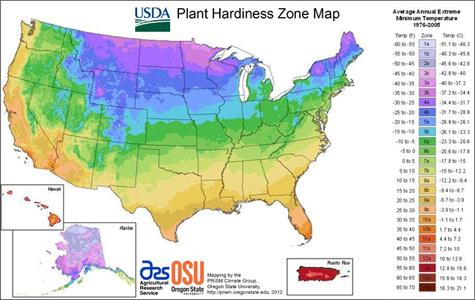
The new map is based on average annual extreme minimum temperatures from 1976 to 2005, whereas the previous map used data from the years 1974-1986. Average temperatures throughout the U.S. were about two-thirds of a degree (F) higher in the more recent time span then they were from 1974 to 1986. As a result, the zones have shifted, and many locations around the country are now in warmer zones than they were on the previous map. Some states, such as Ohio, Texas, and Nebraska, have almost completely migrated to a warmer zone. Of the 34 cities highlighted in the 1990 map, 18 are in warmer zones in the updated version of the map. In general, much of the U.S. is about one-half zone warmer in the new map than in the 1990 edition.
The 2012 version of the planting zones map is the first that is GIS-based. Additionally, a new algorithm used for the 2012 edition enabled more accurate interpolation between weather reporting stations, and the new map also accounts for factors such as elevation changes and proximity to bodies of water, which led to more accurate mapping of the zones. Data used to create the map came from a total of 7,983 stations in the U.S., Canada, and Mexico, including stations of the National Weather Service, the Natural Resources Conservation Service, the Forest Service, the Bureau of Reclamation, the Bureau of Land Management, Environment Canada, and the Global Historical Climate Network.
An in-depth overview of the new map was published in February’s Journal of Applied Meteorology and Climatology. An interactive version of the map and more features can be found here.
AMS/UCAR Congressional Fellowship Application Deadline Approaching
by Jack Fellows and Paul Higgins
Every year the AMS and UCAR together send one member of our community to work for a member of Congress or a congressional committee through its congressional science fellowship program. The deadline for applying for next year’s fellowship is rapidly approaching, so consider now how this opportunity could enhance your career while giving you a chance to help shape the future.
The program has two goals: (1) to ensure that Congressional policy makers have ready access to the best available scientific information; and (2) to provide policy experiences for community members who think they’d like to pursue a policy career (i.e., develop key decision makers for the future).
David Reid-Miller, the 2010-2011 AMS/UCAR Congressional Fellow, served as a Legislative Fellow in Sen. Mark Udall’s (D-CO) office advising him on an array of energy issues. David says of the experience: “The deadlines were often fast and usually changing – and the request never the same. Whether it was clean energy R&D at DOE, fossil fuel subsidies, developing renewable energy on public lands, or crafting the DOD Energy Security Act – I not only learned how to balance the many interests in a “purple” state like Colorado, but I gained enormous insight into the policymaking process and expertise in a range of topics outside my dissertation research. It was a phenomenal experience – the only regret about it is that it only lasted one year!”
The Fellows bring to the Congress new insights, fresh ideas, extensive knowledge, and education in a variety of disciplines. Not only are the Fellows provided with the opportunity to make a significant public service contribution, but they also obtain firsthand experience in the legislative and political process. Fellows gain a perspective which, ideally, should help them understand how the research community effectively communicates with the larger society on important national policy issues. Fellows may have the opportunity to make significant contributions to public policy making within Congress on disaster preparedness and response, global change, water and energy policy, defense technologies, AIDS, pollution, communications technologies, and many other issues.
The AMS/UCAR fellowship is managed along with over 30 other professional science societies by the American Association for the Advancement of Science (AAAS). The AAAS reports that these fellowship programs continue to have significant impact based on: (1) the number of Fellows has increased over the years; (2) there are many more congressional requests for possible assignments than there are Fellows; (3) former Fellows are assuming senior positions in Congress, the Executive Branch, academia, and in the private sector; (4) overall, large numbers of qualified individuals continue to apply to the various sponsoring organizations for the fellowships; and (5) reports from the Congress about individual Fellows and the program have been highly laudatory.
What Fellows Do. Fellows perform every type of work normally asked of the permanent congressional staff, whether they are in members’ offices or with committees. The range of activities is illustrated by these examples:
- Assist in preparation of major parts of legislation from preliminary agency reviews to House-Senate conferences and final enactment into law;
- Work on legislative and oversight activities on budgets for various agencies, such as NOAA, NASA, EPA, the National Science Foundation, the Department of Energy, the Department of the Interior, and the Department of Defense;
- Assist with oversight investigations into major national problems such as global change, hazardous wastes, natural disasters, ground water, acid rain, etc.;
- Help prepare Members for debates on the floors of the House and Senate;
- Write speeches and other materials for Members on a wide range of topics;
- Provide liaison and coordination with committees to which a Member is assigned;
- Give briefings and arrange for public hearings; and,
- Meet with lobbyists, members of the public, agency representatives, and many others.
For example, Kim Mueller, the 2011-2012 AMS/UCAR Congressional Fellow, is currently serving with the U.S. House of Representatives Natural Resource Committee. As part of her assignment on the committee, Kim primarily works on climate change issues, helping to organize briefings for staff and members of Congress, preparing members of the Committee for hearings and events, and researching climate change legislation. Kim also participated in the 17th Conference of the Parties (COP17) to the United Nations Framework Convention on Climate Change (UNFCCC) in Durban South Africa last month.
Fellowship Term, Stipend, Administration, and Application. Fellowships usually run from September through August. The stipend for the Fellow is $55,000, plus allowances toward relocation, in-service travel, and health and dental insurance premiums. AAAS organizes a two-week orientation period in Washington in early September. This orientation includes seminars on the Congress and the Executive Branch; meetings with former Fellows, members of Congress, and staff; and preparing for placement in the Congress. There will be over 30 Fellows in the class, sponsored by over two dozen different societies. Following orientation and interviews on Capitol Hill, the AMS/UCAR Fellow will select a position in the House or Senate. Throughout the year, the AMS/UCAR Fellow will join with other AAAS Fellows in participating in seminars, and social and other class activities sponsored by the AAAS. The AMS/UCAR Fellow will also be invited to attend and report on his or her activities at AMS and UCAR meetings.
We strongly encourage you to apply – see http://www.ametsoc.org/csf. Applications are due to the AMS by March 15, 2012!
How does it feel?
Sunday was supposed to be National Weatherperson’s Day. Did you receive flowers? Did distant relatives call to congratulate you? Did adoring fans of your forecasts voice their support?
Or did the much anticipated holiday pass uneventfully while everybody was preoccupied by lesser events…oh, like the Super Bowl, for instance? Just a case of bad scheduling conflicts, or a conscious attempt to diss you?
If you’re a meteorologist, especially a forecaster, you know how it feels to be underappreciated, to be told you’re not right often enough, that your job is going to be taken by a computer. Not only might you get ignored on the very day meant for you, now you get replaced…by a cube:
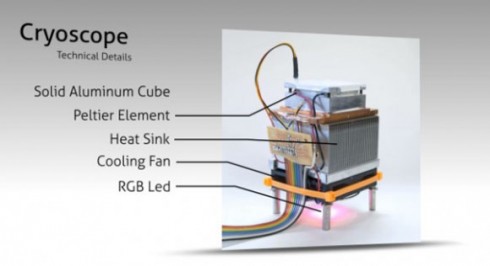
Hook the device to your smart phone weather app and it adjusts its temperature to match the forecast temperature. So that’s how the weather feels! And how does it feel to be replaced by an aluminum box with a heating element and simple sink inside it?
Bob Dylan stuck the knife in with “You Don’t Need a Weatherman to Know Which Way the Wind Blows,” but he twisted it cruelly with:
How does it feel
How does it feel
To be on your own
With no direction home
Like a complete unknown
Like a rolling stone.
A forecaster’s fate? We think not.
Clearly this invention leaves much to be desired. In addition to being unable to prognosticate without a web app, after a decade or more of good minds trying to develop better ways of conveying uncertainty information in weather forecasts in a few words or pictures, here comes a giant deterministic step backward for communicating tomorrow’s conditions. And of course, although inventor Robb Godshaw of Rochester Institute of Technology insists that the Cryoscope compensates for the difference between conducting heat with aluminum versus air (and also effects of wind chill), it is difficult to imagine equating the touch of the hand to how it feels to move and breathe in the atmosphere. No, this box is not how it feels at all.
In fact, there’s a lesson here. Much as it is difficult to teach any scientific concept to a wide audience, let’s keep in mind that over the years people have developed an uncanny sense of how they feel, personally, when it’s 40, or 50, or 60 degrees Fahrenheit and so on (not to mention wiser folks who’ve learned all this in terms of Celsius). In fact, people probably have a much more acute ability to imagine what a 10 degree rise in temperature will feel like than what carrying a 10 pound increase in load will feel like.
The depth to which the temperature scale is ingrained with exquisite sensitivity into our consciousness is summed up by a viewer’s comment on the Cryoscope promo video page:
The step after that would be to hook up a water hose to it to tell you when it is rainy.
Avid Surfer, Forecaster Receives Joanne Simpson Award for Sustained Mentorship of Colleagues
Mark Willis, a development manager and forecast strategist for Surfline—the go-to global surfing forecast company—is the 2012, and first, recipient of The Joanne Simpson Mentorship Award. Willis, a lifelong surfer who is at home when the surf is cranking, won the award for aiding NWS volunteer interns in gaining experience valuable to their future careers through dedicated mentorship, and sustained encouragement and guidance.
The Front Page set out to learn more about Willis and his penchant for mentoring. He worked for Surfline for several years in the late 1990s and early 2000s before joining the NWS Eastern Region marine program. Then, recently, he returned to Surfline. The following is our Q and A session in which Willis sheds some light on his particular style of engagement with colleagues.
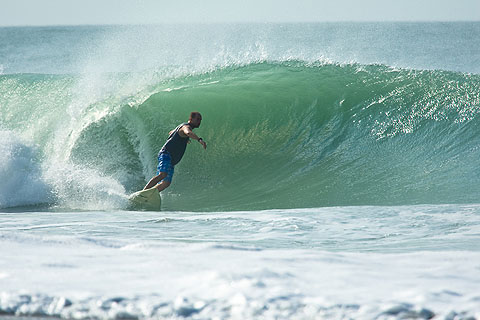
What’s your area of expertise in meteorology? And did that help you secure the most recent position you had with NOAA?
My expertise is in marine and coastal forecasting, but I enjoy all aspects of meteorology and oceanography. My marine background definitely helped me secure my last position at NOAA as the Marine Program Manager at NWS Eastern Region Headquarters.
What was your passion that got you into marine forecasting?
I became interested in marine forecasting through surfing. I grew up surfing on the East Coast and became fascinated by waves and how they changed so quickly. I learned much of the science behind wave forecasting on my own and by working at Surfline as its difficult to get much formal training on the subject. I became involved in ocean wave modeling in graduate school and continued to work on wave modeling projects in the NWS. I’ve been lucky to be able to work in forecast offices that have marine responsibility as this has greatly enhanced my knowledge of the ocean and the atmosphere.
What is your current title and affiliation, and what is it you now do?
Global Forecast Development Manager/Lead Forecast Strategist with Surfline, Inc. Surfline also owns Buoyweather.com and Beachlive.com. My job is to lead Surfline/Buoyweather/Beachlive’s push into international markets and also help to fine tune existing products and develop future products.
Who were the folks you were mentoring?
I have mentored several students and employees throughout my career as a meteorologist. I mentored volunteer interns when I was a forecaster at the NWS forecast office in Newport/Morehead City, North Carolina. Most were college students but I also worked with a couple of high school students. I also mentored new employees when I was the East Coast forecast manager at Surfline in the early 2000s. I have been fortunate that both of my employers have allowed me to mentor, as it’s something I greatly enjoy.
Tell us your philosophy on mentoring and what sets it apart from others’ techniques/methods?
One thing I always thought of when I was working with students and/or new hires was that I was in their shoes not too long ago. I always ask myself, “What would have made me grow and feel more comfortable?” The answer to that was always the same – just make sure they feel welcome, included during forecast decisions, and find the right times to train and teach. I think it’s important not to continuously throw things like QG theory down their throats and show them how much you know. It’s more important to get to know the person, find their learning style, and adapt to the human being. Most of all, get to know who they really are, ask about their family, hobbies, find their true interests in meteorology and just try to educate and mentor where you can.
As far as what sets that apart from others’ techniques/methods – I’m honestly not sure. I did take the student that nominated me for this out surfing a couple of times though where we talked about life and exchanged waves, so maybe that’s what set it apart!
How do you use that to promote excellence in forecasting/the atmospheric sciences?
I just try to be a hard worker, lead by example, and follow my passions. Hopefully that promotes excellence in our ever so humbling field.
Will you continue to mentor in your new position?
Every chance I get. I also hope I get the opportunity to be mentored by some of the veterans at Surfline as well, as they have an incredible staff with the best group of marine/surf forecasters and modelers in the world. Surfline is always looking for the brightest and the best so hopefully I’ll get the opportunity to mentor new employees in the future.
When you first learned you were going to receive this particular award, what was your reaction?
I was shocked when Jon [Malay] called me to tell me the news, honestly. This award is hands down one of the highlights of my career. I have a great sense of pride in the fact that the students and colleagues I mentored went out of their way to nominate me for this.
One additional thing I’d like to highlight on this subject is that the news of the award came right after a very stressful period of dealing with Hurricane Irene both professionally and personally. The award definitely lifted my spirits after that!
What advice would you give a colleague who wanted to win this same award next year?
Be yourself, get to know the people you are mentoring, and find good entry points to train and mentor. Don’t force it.
What single piece of wisdom would you hope those you mentored would carry into their careers?
As the late Sean Collins (founder of Surfline) taught me and inscribed into the Surfers’ Hall of Fame—“Follow your Passions.” You’ll perform much better and find more satisfaction in your career if you enjoy what you are doing.